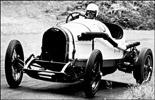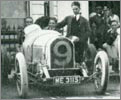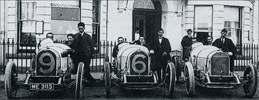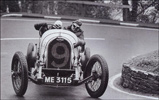|
|
| |
| 1922 Bentley 3 Litre |
|
|
Original 1922 Numbers
Chassis No. 72
Engine No. 60
Registration No. ME 3115
|
|
This car - updated
Chassis No.
Engine No.
Registration No. ME 3115
(Current owner / former owners, please come forward with further updates. - August 2019) |
|
| |
|
|
 |
|
11 May 1996 |
 |
| |
Christies 11 May
1996 London, King Street
Sold £68,600
1922 BENTLEY 3 LITRE T.T. CAR
Registration No. ME 3115 (To be
confirmed by the DVLA)
Chassis No. 72 (See Text)
Engine No. 40
White with brown cloth interior
Engine: 2,996cc, four cylinder non-detachable
head, four valves per cylinder, single
overhead camshaft through bevel drive,
five bearing crankshaft, Claudel-Hobsen
BZP racing carburettor; Gearbox: four
speed and reverse, outside right hand
gear change; Brakes: two wheel drum.
Right hand drive.
In November 1921 W.O. Bentley decided
to enter three cars in the Isle of
Man Tourist Trophy Race. This was
to be an important milestone in the
history of Bentley Motors as a successful
result would effectively ensure a
large number of orders for the 3 litre,
together with a great deal of publicity
for the marque. W.O. Bentley had realised
the importance of the outcome of the
race and even consulted the National
Physical Laboratory for advice on
the aerodynamic streamlining for the
T.T. cars.
The chosen chassis were numbers 42,
72 and 74 and because the Bentley
Team would be up against the experienced
racing teams of Vauxhall and Sunbeam
they featured many modifications over
the standard road cars. Almost every
chassis part was reduced in weight
- connecting rods and flywheel were
lightened, all the steering parts
polished, experimental pistons fitted
and the chassis was clothed with a
lightweight, two-seater streamlined
body made by Ewart and Sons of Euston
Road. The distinctive flat, lightweight
radiators were also made by Ewarts
and further distinguishing features
were the huge straight-through exhaust
system protruding through the nearside
of the bonnet, the outside gear lever
and handbrake, staggered seating and
the horizontal spare wheel clamped
in position in the tail. The bulkheads
were made of plywood sandwiched between
aluminium sheet and, like the radiators,
were approximately 5" lower than
standard (to improve the aerodynamics),
forming an integral part of the body.
The resultant all-up weight of the
finished car, including a full 33
gallons of fuel, oil and water and
wheel changing tools, was 1 ton 3
cwts. The engines were fitted with
a Claudel-Hobson CZP racing carburettor
with a specially cast inlet manifold
and high compression "hourglass"
pistons. A separate oil tank was fitted
beneath the floor boards (so that
the sump oil could be replenished
during the race by the riding mechanic
by means of a hand pump if necessary)
and a high rear axle ratio (14:48),
single Hartford shock absorbers to
the front, with double to the rear,
provided impressive performance and
road holding.
The 1922 T.T. Bentleys were entered
as Nos 3, 6 and 9 and were driven
by F.C. Clement, W.D. Hawkes and W.O.
Bentley respectively. Frank Clement's
racing notebook includes various details
regarding chassis No.72. He describes
that it was run on the road for the
first time at 6.30pm on 11th May 1922,
just five weeks before the Tourist
Trophy race itself. W.O. Bentley drove
the car a number of times over the
following few days, including 420
road miles and on the track at Brooklands,
where he was timed at 90mph with a
strong head wind! It was shipped to
the Isle of Man on 1st June 1922 and
between June 6th and June 20th 16
practice laps had been completed,
equating to 604 miles.
The race itself was to take place
on 22nd June 1922, comprising eight
laps of the famous 37¾ mile
T.T. course. The cars assembled at
9.30am in appalling weather conditions
- Clement and W.O. Bentley quickly
made a makeshift wing for their Bentleys
in an attempt to protect themselves
from the spray, and the various surfaces
of the circuit - Macadam, tar and
stone - were particularly treacherous.
Park in the T.T. Vauxhall started
first, followed by Clement in his
Bentley and Seagrave in the Sunbeam,
and the remainder at 1 minute intervals.
Seagrave's first lap (from the standing
start) was to prove the fastest of
the day, although he was later to
retire with ignition problems. Park,
in the Vauxhall, retired with engine
trouble and Hawkes' Bentley was delayed
by 20 minutes having lost its radiator
plug.
The weather and track conditions gradually
deteriorated and W.O. Bentley noted
that the authorities had sprayed the
circuit with a chemical intended for
laying the dust - this blended with
the mud and worked its way behind
the drivers' goggles, causing a good
deal of pain. W.O. also had other
agonies of his own - he described
the race as the most uncomfortable
experience of his life! On the first
lap the floorboard worked loose and
he lost all ankle support, so for
hours his legs were held up by the
pressure of the pedals alone! Then
over four feet of the huge exhaust
pipe fell off just ahead of the cockpit,
the hot exhaust gases causing a great
deal of discomfort for his navigator,
Leslie Pennal. Pioneering stuff indeed!
On the fifth lap, Swaine (Vauxhall)
retired with engine problems which
left five cars in the race - one Sunbeam,
one Vauxhall and the three Bentleys.
Chassagne in the Sunbeam and Frank
Clement had an exciting battle at
the front, as did W.O. Bentley and
Payne in the T.T. Vauxhall.
The race ended just before 3pm and
Jean Chassagne in the Sunbeam won
averaging 55.28mph. Frank Clement
came in second in the Bentley, having
averaged 55.21mph. The Vauxhall just
managed to beat W.O. Bentley to third
place by six seconds and Hawkes completed
the Bentley trio, coming in fifth.
The Bentleys won the Team prize and
consequently produced the blaze of
publicity needed by the company. Following
the race, W.O. Bentley was quoted
as saying "Our primary motive
was to put the cars in the public
eye and get them talked about... and
the results were very pleasing".
Bentley Motors capitalised heavily
on the team success and produced what
is now an exceedingly rare booklet
entitled "The Blue Riband"
to commemorate this occasion. It was
to be W.O.'s last major race as a
driver - he decided his priorities
lay in running the Works.
The car on offer today has been painstakingly
restored to the original specifications
of the 1922 T.T. Team cars. The restoration
was carried out by a well-known and
highly respected Bentley enthusiast,
the late Cyril Wadsworth, who previously
had spent many years researching the
whereabouts of the three T.T. chassis.
He discovered that they had been sold
by the Works over a period of eighteen
months following the 1922 race, and
although they had not been heard of
since 1937 they had never officially
been scrapped.
Team Car No.9 (chassis No.72) was
sold by the Bentley Motors Works Team
in September 1922 to Mr. Richard Edge,
who fitted Harrison open four seat
touring coachwork. He kept the car
until 1924, selling it to a Mr. T.F.
Aspin. It then passed into the hands
of L.W. Boyce, who in approximately
1926, sold it to R. Pitt. Mr. Pitt
kept the car until 1933, when he sold
it to Mr. E.J. Loftus, who in turn
sold it to Miss K.J. Kennedy-Clarke
in 1936. The history is not recorded
from 1936 until 1965 when Cyril Wadsworth
reported he had discovered a derelict
chassis frame and rear axle, although
it is known that the car was stolen
pre-war and was not recovered. The
fascinating story of this discovery
and subsequent reconstruction of the
car is told by Cyril Wadsworth in
a number of reports written for the
Bentley Driver's Club Review (Nos
81, 84, 88, 95, 103, 110 and 113)
over the period of July 1966 to August
1974, and we would recommend that
potential purchasers of the car read
these articles which are extremely
informative and detail all aspects
of the restoration.
The discovery materialised in the
Spring of 1965 when Cyril Wadsworth
purchased the 9' 9½" chassis
frame with springs and a rear axle
casing. This was documented in the
BDC Review of July 1966 when Cyril
wrote "when this was collected
it was found to be of 1922 origin
- easily confirmed by the spacing
of the running board bracket holes
and the two holes in the front gearbox
cross member for the swinging lever
of the brake linkage used with the
"diff." type compensator.
The frame and axle casing were most
interesting as the frame had a hole
for an outside gear lever, together
with other holes in various places
which corresponded with holes used
on the T.T. cars for such fittings
as the extra oil tank, outside petrol
filter, bonnet catch brackets, undertrays,
etc., The rear axle casing also was
unusual in that the forged bosses
on opposite sides to the brake anchor
rods had been removed. These were
usually left on but removed on the
T.T. cars. There seemed to be some
possibility that I had found one of
the genuine frames!" He then
explained how he could not raise any
numbers on the chassis (perhaps they
had been removed when chassis 72 was
stolen?) except for the traces of
a figure "2" stamped on
the nearside dumb iron and went on
to say..."The "2"
was the last figure of a two figure
number and though I polished the dumb
iron and etched to try and raise another
number I was not able to do so. Still,
it could be either 42 or 72 - I like
to think it is - and this frame was
sent to Rubery Owen who trued and
straightened it, re-rivetted, shot-blasted
and primed it."
Having established in his own mind
which of these exciting cars he had
unearthed, Wadsworth commenced the
rebuild of the car. He purchased a
correct-period front axle and rebuilt
the early 3 litre engine (No.40) to
the correct T.T. specifications including
fitting an original set of hourglass
high compression pistons and a genuine
Claudel-Hobsen BZP racing carburettor
and manifold. The rear axle was rebuilt
using a 2.86:1 ratio and a new body
was manufactured, this being an exact
copy of the original.
In fact, Wadsworth was very good friends
with Leslie Pennal, W.O. Bentley's
riding mechanic for the 1922 T.T.
Race and Pennal provided valuable
input into the reconstruction of this
car, (again documented in the Bentley
Drivers Club Reviews). During the
course of the body's manufacture he
even visited the workshops several
times in order to ensure the accuracy
of the dimensions of the coachwork.
A new radiator to the original specification
was also made and the attention to
detail throughout the whole car is
outstanding.
Upon completion, Wadsworth used the
car in various VSCC races and events
where it created quite a sensation.
It is finished in the original team
colours of white with a red chassis
and is tremendously exciting to drive,
with very responsive and direct steering,
predictable handling and excellent
performance. Indeed, the lightweight
construction of the Team cars enable
it to accelerate quickly and yet still
pull the high rear axle ratio, so
at 70mph the engine is turning over
at just under 2000rpm.
This important car has resided in
one of Japan's premiere collections
for over twenty years and in March
1996 returned to the Isle of Man where
an extensive road test was carried
out on the T.T. circuit. Ironically
the weather conditions were as appalling
as in the 1922 T.T. race, although
the car performed admirably and aroused
a good deal of interest from enthusiasts
as well as the press.
There is a wealth of fascinating reading
and photographs available on all three
T.T. Bentleys and the race itself,
and particular attention is attributed
in the following titles - "Racing
History of the Bentley" by
Lt.Col. Darell Berthon (pp 13-19),
"Illustrated History of the
Bentley Motor Car" by W.O.
Bentley (pp 92-96), "The Other
Bentley Boys" by Elizabeth
Nagle (pp 67-81), "The Autocar"
July 1st 1922, "Bentley Factory
Cars" by Michael Hay (pp
101-106) and "Bentley - The
Vintage Years" by Michael
Hay (pp 234-237).
Specific photograph references of
chassis No.72, No.9 race car are as
follows - "Bentley - 50 years
of the Marque" by J.R.A.
Green (p138), "Those Bentley
Days" by A.F.C. Hillstead
(p80), "Auto Motor Journal"
29th June 1922 (p537), "Tourist
Trophy" by Richard Hough
(p113), "Cricklewood to Crewe"
by Michael Frostick (pp75-78 and ;80)
and "My Life and My Cars"
by W.O. Bentley (p57). |
|
| |
|
|
| |
|
|
| |
Source:
Christie's |
|
| |
Posted:
Sep 24, 2010 |
|
| |
|
|
|
|
 |
| Click
on thumbnail for larger view |
 |
|
|
|
| |
 |
| |
Chassis No. 72 was
available at Christie´s Beaulieu
sale on July 8, 1976
1922 Bentley 3-Litre T.T-Type Two-Seater
Racing Replica
Reg. No. ME 3115 Chassis No. 72 Engine
No. 40
Engine, four-cylinder, overhead-camshaft,
monobloc, bore 80mm., stroke 149mm.,
capacity 2,996 c.c.: dual magneto
ignition: four-speed gearbox, right-hand
change: shaft and bevel drive: foot
and handbrakes on rear wheels: suspension
semi-elliptic front and rear: wheelbase
9ft. 9 1/2in.: tyre size 820 x 120:
model not catalogued.
The elements of this car were acquired
in scrap condition in 1961. Between
1966 and 1974 it was reconstructed
to authentic 1922 Tourist Trophy Team
specification, using genuine 1922
Bentley components. Of these, the
chassis frame is known to have come
from either W. 0. Bentley's fourth-place
machine (No. 72) or Frank Clement's
(No. 42) which came in second; the
former car is the more likely. Front
and back axles (numbered 74) are from
W. D. Hawkes's T.T. machine. The engine
(No. 40) was made in 1922, and has
been rebuilt to T.T. specification,
with lightened flywheel, 5mm. off
the block, and original hourglass
pistons. Original-type tulip valves
and the 1800 camshaft are fitted.
Magnetos are 1922-make M.L. G4s, and
both inlet manifold and Claudel-Hobson
BZF carburetter came off the Hawkes
car. A new 1922 water pump has been
fitted, the cone clutch has a T.T.-type
clutch stop, and crank and rods are
polished.
The gearbox (No. 100) is a 1922 'A'
close-ratio model with 5 D.P. gears
and has been fully re-raced. It has
the outside lever and inboard reverse
latch as used in the T.T. Transmission
is by standard pot-joint prop shaft,
fully reconditioned with new blocks
and slippers. The Back axle has a
new, straight-cut 2.875/1 ratio crown
wheel and pinion on a special two-star
racing differential, re-raced and
with new differential gears. The brakes,
of correct type on the rear wheels
only, have been relined and the lightened
drums are unworn. Rear hubs have been
resplined, and all front and rear
hub ball races renewed. Five new 820
x 120 beaded-edged wheels with tyres
and tubes have been fitted approximately
100 miles ago. The steering column
(No. 19) is original 1922 with long
top arm giving about one turn from
lock to lock. Petrol tank and air
pressure system are original 1922,
as are the radiator and tank badges,
re-enamelled in garter blue. The instrument
panel is replica, though all instruments,
except the air pressure gauge (of
later Smiths' type) are authentic.
The body, flat radiator, and exhaust
system are exact replicas of the originals,
and were made late in 1973. The aluminium
two-seater racing shell was constructed
under the supervision of Leslie Pennal
(W.O.'s riding mechanic in the race)
by Roger Cook of Wroughton. Exterior
finish is in the correct finish for
the 1922 T.T.-off-white body, red
frame, axles, and running gear, and
black wheels, fuel tank, full-length
undertray, and exhaust system. The
interior has been trimmed in the original
material-brown velvet cord. No road
equipment is fitted, and the vehicle
has not been licensed for road use.
It has covered some 100 miles since
running-in, which includes a successful
competition season in 1974. Among
the vehicle's achievements have been
a standing-start kilometre in just
over 37 sees. (Ghent and Brighton)
and a one-way flying kilometre at
92 m.p.h. (Ghent), performances which
equalled the vehicle's showing when
new. Weight is between 17 and 18 cwt.
and condition is to concours standards
throughout. The car has been written
up in sundry issues of the Bentley
Drivers' Club Review, and also in
Autocar (July 26, 1975). The property
of C. Wadsworth, Esq. |
|
| |
|
|
| |
|
|
| |
Source:
From a Christie's Beaulieu sales catalog
dated July 8, 1976
Made available by Michael J. Immecke
Posted: Jul 16, 2007 |
|
| |
|
|
|
|
 |
| Click
on thumbnail for larger view |
 |
|
|
|
| |
 |
| |
1922: The T.T., Isle
of Man, Left to right: Ex No. 3 'W.O.'
and Pennal; Hawkes and Browning; Clement
and Saunders; and Hillstead and Ex
No. 2 (the practice car). |
|
| |
|
|
| |
|
|
| |
Source:
Article
by Darell Berthon in Profile Publications,
1967
Posted: May 24, 2007 |
|
| |
|
|
|
|
 |
 |
| |
Chassis No. 72 originally
had Engine No. 60, but when it was
rebuilt Engine No. 40 was put in.
And Engine No. 40 was originally in
Chassis No. 38. |
|
 |
|
|
 |
| Click
on thumbnail for larger view |
 |
|
|
|
| |
 |
| |
The initiators of
a famous facing marque: the Bentley
team of 3 litre cars, which finished
intact in the 1922 Isle of Man T.T.
race.
The Bentley 3-Litre team cars lined
up outside the Prince of Wales Hotel
before the 1922 TT race. Left to right:
Clement, Saunders, W.O., Penned, Hawkes,
Browning |
|
| |
|
|
| |
|
|
| |
Source:
From article, Great
Racing Marques: Bentley, published
in "Motor Sport" magazine,
December 1933
Posted: Mar 10, 2008 |
|
| |
|
|
|
|
 |
| Click
on thumbnail for larger view |
 |
|
|
|
| |
 |
| |
|
|
| |
|
|
| |
|
|
| |
Source:
Visipix
Posted: Sep 13, 2010 |
|
| |
|
|
|
|
 |
|
|
|
 |
| EARLIEST
RECORD OF HISTORICAL FACTS & INFORMATION |
 |
 |
| |
| Chassis No. |
72 |
| Engine No. |
60 |
| Registration
No. |
ME 3115 |
| Date of Delivery: |
Dec 1922 |
| Type of Body: |
2-seater |
| Coachbuilder: |
Ewart |
| Type of Car: |
TT  |
| |
|
| First Owner: |
EDGE D |
|
|
| |
|
|
| |
More Info:
Michael Hay, in his book Bentley:
The Vintage Years, 1997, states:
"4th 1922 TT. Rad, body and bonnet
fitted to ch. 221 this chassis fitted
Harrison tourer. Chassis frame believed
in TT replica built by Wadsworth - but
see also ch. 22. TT replica fitted engine
40 ex ch. 38." |
|
| |
|
|
| |
|
|
| |
Posted: Sep 26, 2006 |
|
| |
|
|
|
|
| |
| |
| |
| Submit
more information on this car |
| |
| |
| |
|
|
| |
| |
| |
 |
| |
| |
|
| |
|
 |
 |
 |
Sep 30, 2020 - Info and photograph received from Simon Hunt for Chassis No. RL3439 |
 |
 |
Sep 30, 2020 - Info and photographs received from Dick Clay for Chassis No. 147 |
 |
 |
Sep 29, 2020 - Info and photographs received from Ernst Jan Krudop for his Chassis No. AX1651 |
 |
 |
Sep 28, 2020 - Info and photographs received from Lars Hedborg
for his Chassis No. KL3590 |
 |
 |
Sep 25, 2020 - Info and photograph added for Registration No. XV 3207 |
 |
 |
Sep 24, 2020 - Info and photograph added for Registration No. YM 7165 |
 |
| [More] |
 |
|
|
|
 |
|
|
 |
 |
 |
|
CLUB TALK
Upcoming Vintage Bentley Events |
 |
|
|
 |
 |
 |
|
|
 |
| |
|